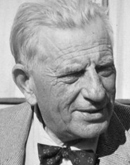

Jaroslav J. Polívka
*20. 4. 1886 – Prague, Czech Republic
†9. 2. 1960 – Berkeley, USA
Biography
Jaroslav Josef Polívka was a Czech civil engineer who collaborated with American architect F.L. Wright from 1946-59. He studied civil engineering at the Technical School and at ETH Zurich. He obtained his doctorate in 1917 from the Czech Technical University in Prague.
After military service in World War I, he opened a consulting office in Prague. He was an expert in stress analysis in reinforced concrete structures. In Prague, he worked with Josef Havlíček on the construction of the Habich Palace (1927-28) and the Chicago Palace (1925-27).
For Jaromír Krejcar, he designed the steel structure of the Czechoslovak pavilion for the World Expo 1937 in Paris, and for Kamil Roškot, the structure for the Czechoslovak pavilion for the World Expo in New York in 1939. After the German occupation, Polívka emigrated to the United States and became a professor at the University of California, Berkeley. From 1946 until the death of F.L. Wright in 1959, he collaborated on seven projects, two of which were realized: the S.C. Johnson Wax in Racine (1946–51) and the Guggenheim Museum in New York (1943-59).
Jaroslav Josef Polívka was a Czech civil engineer who collaborated with American architect F.L. Wright from 1946-59. He studied civil engineering at the Technical School and at ETH Zurich. He obtained his doctorate in 1917 from the Czech Technical University in Prague.
After military service in World War I, he opened a consulting office in Prague. He was an expert in stress analysis in reinforced concrete structures. In Prague, he worked with Josef Havlíček on the construction of the Habich Palace (1927-28) and the Chicago Palace (1925-27).
For Jaromír Krejcar, he designed the steel structure of the Czechoslovak pavilion for the World Expo 1937 in Paris, and for Kamil Roškot, the structure for the Czechoslovak pavilion for the World Expo in New York in 1939. After the German occupation, Polívka emigrated to the United States and became a professor at the University of California, Berkeley. From 1946 until the death of F.L. Wright in 1959, he collaborated on seven projects, two of which were realized: the S.C. Johnson Wax in Racine (1946–51) and the Guggenheim Museum in New York (1943-59).
The English translation is powered by AI tool. Switch to Czech to view the original text source.











